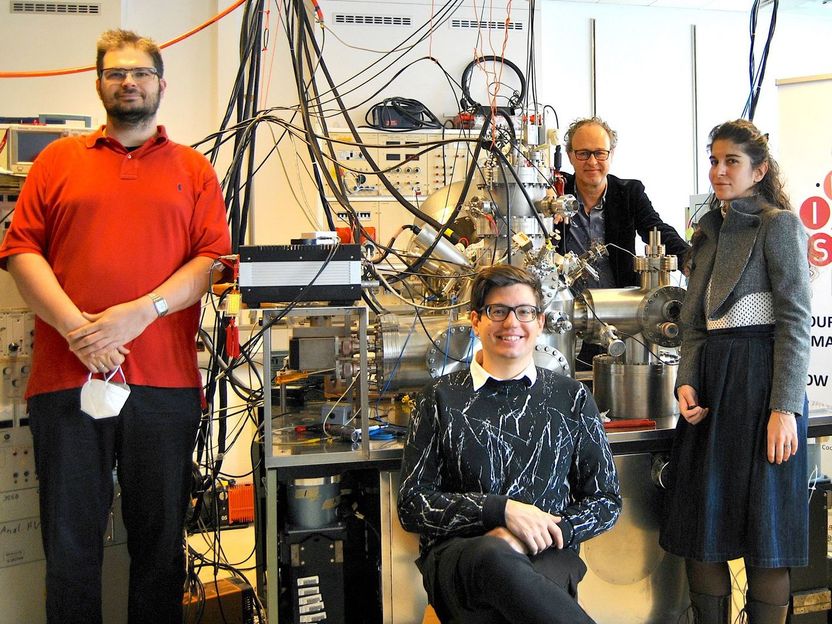Understanding microplastics - with high-speed cameras
How microplastic particles spread in the ocean depends on microscopic details
microplastics are a global problem: they end up in rivers and oceans, accumulate in living organisms and disrupt entire ecosystems. How tiny particles behave in a current is difficult to describe scientifically - especially in the case of thin fibers, which make up more than half of the microplastic contamination in marine life. Their movement can hardly be predicted in turbulent currents.

Giuseppe Caridi (left) and Vlad Giurgiu (right)
© Dalmonia Rognean
TU Wien has now succeeded in precisely characterizing the behaviour of such microplastic fibres in experiments in a flow channel with the help of high-speed cameras. This should now form the basis for new models that can be used to predict the spread of microplastics globally. The results have been published in the journal "Physical Review Letters".
Small, curved fibers
"How microplastic particles move, disperse and deposit depends on their rotational dynamics," explains Vlad Giurgiu, first author of the current publication and doctoral student in Prof. Alfredo Soldati's team at TU Wien. "This is easy to analyze for nearly spherical particles. But you often have to deal with elongated, curved microfibers." In this case, complicated effects occur: The fibers can rotate in all three spatial directions, and this rotation also influences their interaction with the surrounding flow.
"In a perfectly uniform, laminar flow, we could theoretically predict the behavior of simple objects, for example spheres or ellipsoids," says Marco De Paoli (Institute of Fluid Mechanics and Heat Transfer, TU Vienna). "But in the real world, you're not dealing with perfectly laminar flows, nor with perfectly symmetrical particles. Instead, turbulence occurs and the particles have complex geometric shapes that significantly influence the transport and make a theoretical prediction impossible."
It is difficult to calculate exactly what happens. "There have already been various computer simulations, but they are based on simplified models to describe the behavior of the fibers," says Vlad Giurgiu. "You therefore need experimental data with which you can compare and improve the theoretical models."
It is precisely this data that can be measured at TU Wien's flow channel at the Science Center (Arsenal, Vienna). Controlled flows can be generated over a path length of 8.5 meters. Small, curved microplastic fibers with a length of around 1.2 millimeters were introduced into the water and exposed to a turbulent flow.
Six cameras see more than two
The team installed six special cameras just above the surface of the water: high-resolution images of the microplastic particles in the current were collected at a frequency of 2000 images per second. The three-dimensional position and orientation of each individual microplastic particle can then be calculated from the images. "Theoretically, this would also work with just two cameras, but with six cameras, the data is even more reliable and accurate, especially when the concentration of particles is high," explains Giuseppe Carlo Alp Caridi, co-author of the study and head of optical reconstruction at the Institute of Fluid Mechanics and Heat Transfer.
In this way, a large amount of data can be extracted about the movement behavior of hundreds of thousands of microplastic particles and then examined statistically. "It turned out, for example, that the fibers behave very differently near a wall than in the middle of the liquid flow, far away from the walls," explains Vlad Giurgiu.
This means that reliable data is now available for the first time to validate theoretical calculation models on the behaviour of such particles. In future, this should also make it possible to predict the spread of microplastic fibers on a large scale.
"Imagine you have a ship that can filter microplastics from seawater," says Marco De Paoli. "Then you need to know where best to send this ship - because the ocean is big. If you understand the behavior of the particles precisely, then the answer can be calculated with great reliability."
Note: This article has been translated using a computer system without human intervention. LUMITOS offers these automatic translations to present a wider range of current news. Since this article has been translated with automatic translation, it is possible that it contains errors in vocabulary, syntax or grammar. The original article in German can be found here.
Original publication
Other news from the department science

Get the chemical industry in your inbox
By submitting this form you agree that LUMITOS AG will send you the newsletter(s) selected above by email. Your data will not be passed on to third parties. Your data will be stored and processed in accordance with our data protection regulations. LUMITOS may contact you by email for the purpose of advertising or market and opinion surveys. You can revoke your consent at any time without giving reasons to LUMITOS AG, Ernst-Augustin-Str. 2, 12489 Berlin, Germany or by e-mail at revoke@lumitos.com with effect for the future. In addition, each email contains a link to unsubscribe from the corresponding newsletter.
Most read news
More news from our other portals
Last viewed contents
Designed trees that make it easier to produce paper
Condensed_matter_physics
PerkinElmer Releases Second-Generation Non-Contact Microarray Production Tool
Sodium_carbonate
Zeta_potential_titration
Ozone detection
Hyundai_Enercell
A micro-supercapacitor with unmatched energy storage performance

On the edge of friction - Precise insight into how two microscopic surfaces slide over one another could help in the manufacture of low-friction surfaces
New technique 'sees' radioactive material even after it's gone
Orlov_(diamond)



























































